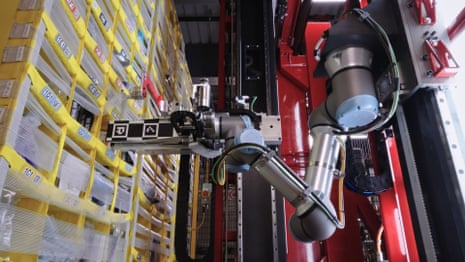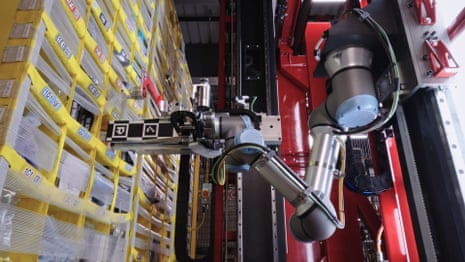Amazon Introduces Vulcan Robot, a ‘Fundamental Leap Forward in Robotics’
Amazon has announced a significant breakthrough in robotics with the development of its new Vulcan robot, designed to work alongside humans in its vast warehouses. The robot is equipped with a sense of touch, enabling it to identify and handle a wide range of items.

The Vulcan robot is capable of grabbing approximately three-quarters of the items in Amazon’s warehouses, according to the company. It will be used to help humans sort items for storage and prepare them for delivery. The robot uses AI to determine what it can and cannot handle and figures out the best way to pick up objects.
Aaron Parness, Amazon’s director of robotics, described Vulcan as a ‘fundamental leap forward in robotics.’ ‘It’s not just seeing the world, it’s feeling it, enabling capabilities that were impossible for Amazon robots until now,’ he said.
The introduction of Vulcan is likely to raise concerns about job losses as retailers increasingly automate their distribution centers. However, Tye Brady, Amazon’s chief technologist of robotics, emphasized that robots are not intended to completely replace humans. ‘People will always be part of the equation,’ he said. ‘Machines will take on the menial, mundane, and repetitive tasks.’
Brady likened the robots to R2D2 from ‘Star Wars,’ describing them as ‘amazing collaborative robots.’ He highlighted the importance of human involvement in the operation, citing the ability of humans to detect potential hacks and identify issues such as broken or spilt items.
The development of Vulcan is part of Amazon’s broader efforts to enhance its robotics capabilities. The company now has over 750,000 robots in operation in its warehouses worldwide. The introduction of Vulcan is expected to improve safety and efficiency in Amazon’s warehouses.
Amazon is also planning to install new technology that uses machine learning and automation to create customized packaging, reducing waste. More than 70 machines will be installed in several European countries by the end of the year, with additional installations planned for 2027.


